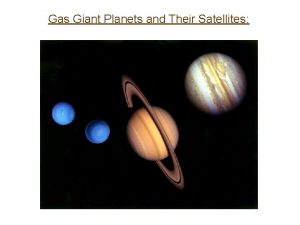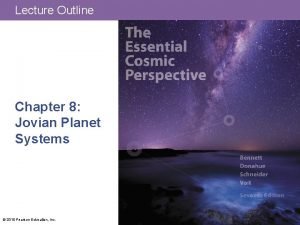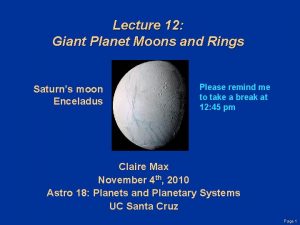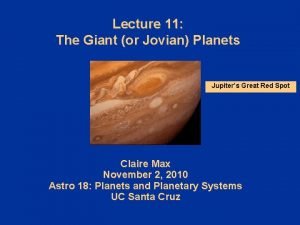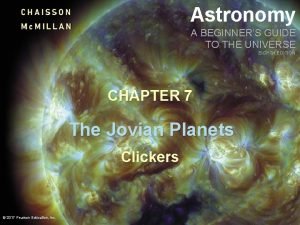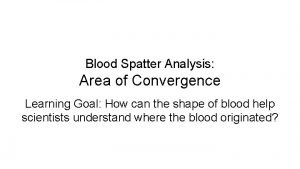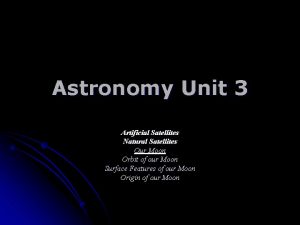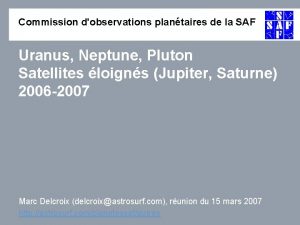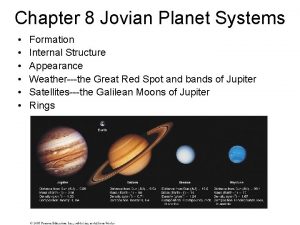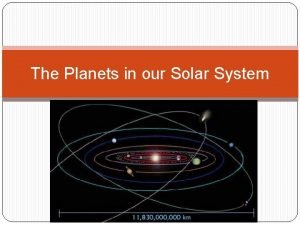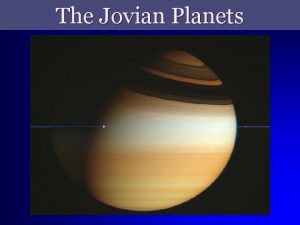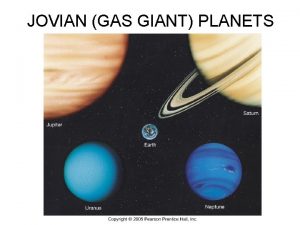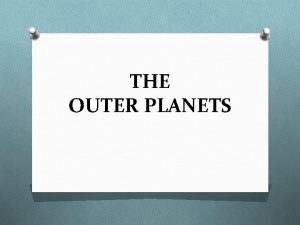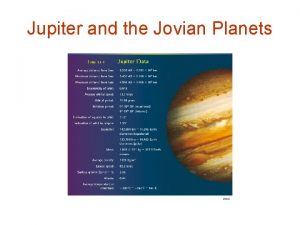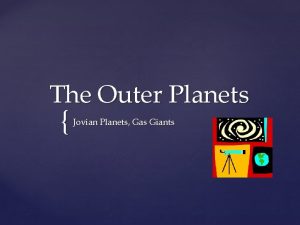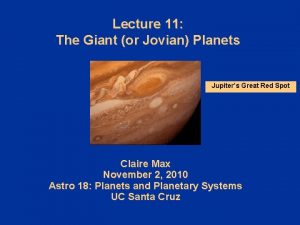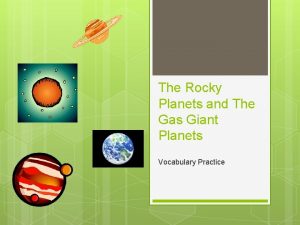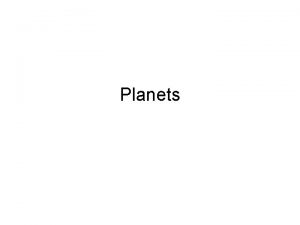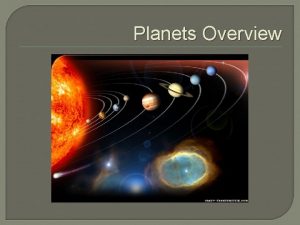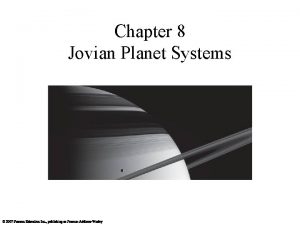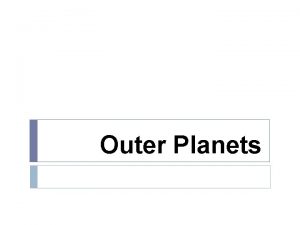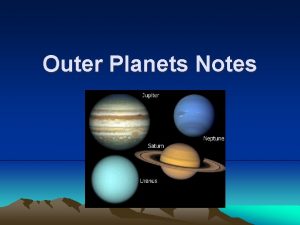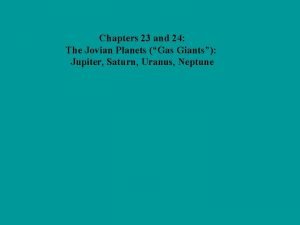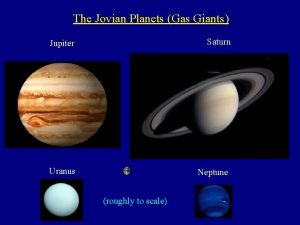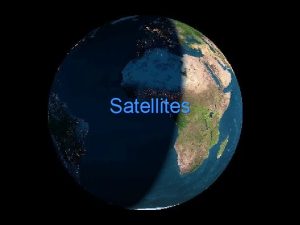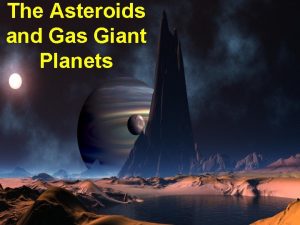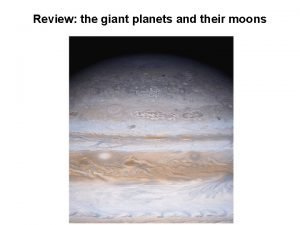Gas Giant Planets and Their Satellites Jovian Planets

































- Slides: 33

Gas Giant Planets and Their Satellites:

Jovian Planets – A Brief Inventory: The largest planets in the solar system are the ones we are least likely to visit in person. • The primary distinguishing feature of Jovian (or gas giant) planets is their lack of a surface. • Their composition is similar to the Sun (mostly H and He, with small amounts of everything else). This is a remnant of how they formed. • Their densities are also similar to the Sun (1 gm cm-3) • They are also fluid bodies like the Sun, which means that they rotate differentially.

• Differential rotation is like water stirred in a pot. The material in the center rotates at a different speed than at the edge. • For a Gas Giant we can think of its interior as a series of cylinders each moving with its own angular speed. • The size and relative speed of the cylinders depends on the interior. sphere Oblate spheroid • The Giant Planets also rotate very rapidly, which distorts them from a spherical shape. • A cloud on the equator of Jupiter is moving 45, 000 miles an hour!

How are we Able to Know This? Clouds!!!! • Clouds on the Jovian planets are structurally unimportant, but they can be followed to show the larger structure of the outer layers. • In the outer solar system clouds can be made of more than just water. • They also can be made of Methane, Ammonia, Amonium Hydrosulfide, Phosphine, Ethane, and other Aerosol compounds. • Each type of cloud has a different color.

• Where the clouds form is a function of temperature and pressure in the planet’s atmosphere. • Different colors probe different levels in the atmosphere!

Clouds and Mapping the Jovian Planets. The depth of the cloud and aerosol layers is determined by the temperature and pressure profiles of the atmosphere. • Jupiter is the warmest of the Jovian planets, and it’s clouds are at the highest altitudes. This enhances their contrast. • Watching the movement of the clouds tells us about the underlying convection patterns of the atmosphere. • The banded structure shows zones and belts of convective motion in the atmosphere

• On Saturn the clouds are deeper and the contrast lower. • Uranus and Neptune have clouds very deep and very few visible features in their atmospehres (especially Uranus).

Interiors of the Gas Giants: From the combination of shape (oblateness), Rotation Rate, and composition we are able to determine the interior properties of the gas giants. • The gas giants differ from the Sun in the way that they are organized. • While both are composed mostly of H and He, the Sun is held up by Fusion, which heats the interior to millions of degrees, while the Jovian planets are supported by pressure. • Each has differentiated to form a fluid mantle around a (possible) rocky core several times more massive than the Earth, which is in turn covered by a layer of compressed gas.

• In the case of Jupiter and Saturn the mantle consists of an exotic substance called ‘metallic hydrogen’. • Uranus and Neptune have less Hydrogen, are cooler, and are smaller. Their mantle is likely to be composed of pressurized water ice.

Cooling Down: The interiors of the Jovian planets are very hot (5, 000 -20, 000 K). • Unlike the terrestrial planets, which are shielded by their crust, the heat escapes from gas giants via convection, just like on the Sun. • If this happened on Earth, it would be a cold rock today. • All the Jovian planets produce more energy than they receive from the Sun except Uranus. So where does the energy come from? • Partly it comes from the initial formation of the planets. For the much cooler Jovian worlds (50 -150 K), it takes longer for this heat to escape. • Some energy is generated by on-going differentiation, where heavy material falls to the center of the planet. • And yet more energy comes from simple contraction. A cooler interior compresses more.

What Happened to Uranus? Uranus is one of the strangest objects in the solar system. • It’s rotational axis is tilted almost 90° from the norm into the plane of its orbit. This makes its seasons the most extreme of any planet. • Uranus’ magnetic field is offset from its center and tilted by 59°. • Uranus produces less heat than the other jovian planets. • Its larger satellites are denser than the other objects their size in the outer solar system. • What Happened? ?

Giant Planets-Giant Dynamos: Convective motions of ice and liquid Hydrogen do more than just transfer heat. They produce magnetic fields. • All of the Jovian planets have strong magnetic fields. • The depth of the dynamo region determines how much like the Earth it is (dipolar and aligned to rotation). • Saturn is most like the Earth. Uranus and Neptune are VERY different.

Giant Planet Magnetospheres: While all of the giant planets have strong fields, their solar wind interactions are very different. • The increasing distance from the Sun plays a role. • The magnetic field and rotation axis orientations are important for both Uranus and Neptune. • For Jupiter and Saturn, it is their satellites that define the interaction.

Jupiter: The Jovian Magnetosphere is extreme in many ways. • Jupiter has the strongest magnetic field of any planet. • Its magnetosphere is also the largest continuous structure in the solar system, stretching all the way to Saturn. • The connection the Jupiter’s ionosphere produces bright aurora with an energy output equal to the entire USA. Sun

Jupiter’s Little Helper: Strangely enough, Jupiter is not responsible for the size of its magnetosphere. • The primary driver is an unlikely source. Jupiter’s moon Io! It took Voyager to discover this. • Io is the most volcanically active object in the solar system! • Io’s volcanoes don’t produce lava, they produce liquid sulfur, mixed with sodium and sulfur-dioxide! • They are recovering Io at a rate of 10 cm/yr.

Stretching Io: • Its volcanoes spray material far above the surface. • What’s driving this? TIDES!!!! • Every time Io is aligned with Jupiter and the Moon Europa it is stretched. This heats the moon. • Escaping atmosphere forms a torus of gas and plasma around Jupiter

Torus and Jupiter: • The Io plasma torus rotates with Jupiter’s magnetic field, which is 75 km/sec faster than Io orbits. • The plasma in the Io torus helps to inflate Jupiter’s magnetosphere and modulates the solar wind interaction. • We used to think that Io and its torus controlled the entire system, but that turns out to be only partly true.

Other Jovian Moons (Ganymede): • Ganymede is the largest Moon in the solar system. • Its interior appears to be fully differentiated (like Earth) with an icy-slush mantle around a rocky core. • Its surface is relatively young, suggesting an active, warm interior similar to Earth. • Ganymede is large and cool enough to retain an atmosphere. Why doesn’t it?

Ganymede’s Secret: • The big surprise from Galileo was the fact that it has a magnetic field! • This makes it the only moon in the solar system with one. • What is doubly interesting is that Ganymede is inside Jupiter’s magentosphere! • HST has observed aurora from the interaction between these two fields and the thin exosphere of Ganymede.

Europa (Jupiter): Europa has generated tremendous excitement due to the possibility that it may harbor conditions favorable to LIFE. • Europa is the smallest of the Galilean (Large Jupiter) Moons, but its density is twice that of other icy moons. • It is also heated by the same process of tides as Io. • At first glance Europa isn’t terribly interesting. • But appearances are deceiving.

Europa (Jupiter): • When we look closer we see chaotic terrain. • Where might we have seen this before?

Europa: • It looks as though Europa’s water mantle is liquid! • Tidal heating appears to be keeping liquid perhaps via deep volcanic activity. • If this is true, then Europa has more liquid water than the rest of the solar system combined!!!! • If the volcanic theory is correct…. • Where there’s smoke…there could be LIFE!!!

Saturn: Saturn’s magnetosphere, like the planet itself, is similar to Jupiter’s, but smaller in scale. • The physical diameter of Saturn’s magnetosphere is about that of the Sun. • The aurora of Saturn are about 200 times less intense. • Saturn’s magnetosphere is somewhere between Earth and Jupiter. • Solar wind conditions are significant, but not all-important.

Rings: Saturn’s ring system plays a role very similar to Io does on Jupiter. Their origins are even similar. • Like Io, the rings of Saturn are the result of tides and orbit resonances. • And, as with Io, the rings contribute small amounts of gas that become ionized, inflating the magnetosphere. Oxygen Hydrogen

Enceladus Though very small (300 miles across) Enceladus has dominated the news from Saturn of late. • Before Cassini we knew that Enceladus had the highest reflectivity of any object in the solar system. Its surface shows evidence of old and new regions. There also craters that look to be modified by flows from the interior. The South polar regions were poorly imaged by Voyager but seemed to be the apex of the new terrain.

Enceladus Cassini has passed close to Enceladus a few times and has made many discoveries. • The South pole is streaked with parallel cracks. • Thermal imaging shows these regions to be MUCH hotter than the rest of Enceladus.

Enceladus Cassini has passed close to Enceladus a few times and has made many discoveries. • Last fall the Cassini team announced the discovery of a huge gas plume emanating from the South pole! Enceladus is very strange indeed….

Titan: Titan is the only large (Galilean sized) moon in the Saturn system. • It has a unique distinction among all satellites…… • Titan has a thick global atmosphere!!! • Titan’s atmosphere is thicker than any other solid body’s except Venus. It’s surface pressure is 1. 6 x greater than Earth, but the column (mass) of it is 10 x greater.

Titan (Saturn): • Voyager found a world covered in a hydrocarbon haze where organic molecules rained onto the surface. • To study this world more closely, Cassini spacecraft was equipped with cameras that could penetrate the clouds. • Bright areas are higher. • Dark areas are low and flat. • There is evidence for volcanoes.

Titan (New Data): A closer look reveals yet more detail. There is evidence of bays and channels consistent with shorelines.

Titan (New Data): A closer look reveals yet more detail. There are even features that look exactly like lakes! Of course, you shouldn’t plan on swimming in these lakes. They’re made of liquid methane!

Titan (Huygens): The landing of Huygens got us an even closer look at one region. Details are apparent from above. Flow channels are obvious. On closer examination you can almost see a shoreline!

Titan (Huygens): Whatever the dark regions contained when the ‘shorelines’ formed, they are ‘dry’ today. Here is a true color image of the surface The ‘boulders’ up front are less than 1” in diameter and are made of ice.
 How are terrestrial planets different from jovian planets?
How are terrestrial planets different from jovian planets? Huygens
Huygens Jupiter is noticeably oblate because
Jupiter is noticeably oblate because Why do jovian planets have rings
Why do jovian planets have rings Why do jovian planets have rings
Why do jovian planets have rings Why do jovian planets have rings
Why do jovian planets have rings Saturn is noticeably oblate because
Saturn is noticeably oblate because What separates the inner planets and outer planets
What separates the inner planets and outer planets The inner solar system by leslie
The inner solar system by leslie Inner planets and outer planets
Inner planets and outer planets Solar power satellites and microwave power transmission
Solar power satellites and microwave power transmission Name four outer planets
Name four outer planets Uses of polar satellites
Uses of polar satellites Exhibition for satellites
Exhibition for satellites Bromidification
Bromidification Name of natural satellite
Name of natural satellite Satellites in orbit around earth continually fall toward
Satellites in orbit around earth continually fall toward San diego sms satellites
San diego sms satellites The formation of the solar system
The formation of the solar system Neptune jovian
Neptune jovian Jovian
Jovian Planets saying
Planets saying Gas law
Gas law Difference between ideal gas and real gas
Difference between ideal gas and real gas Ideal gas vs perfect gas
Ideal gas vs perfect gas An ideal gas is an imaginary gas
An ideal gas is an imaginary gas Ideal gas vs perfect gas
Ideal gas vs perfect gas Gas leaked in bhopal gas tragedy
Gas leaked in bhopal gas tragedy Gas leaked in bhopal gas tragedy
Gas leaked in bhopal gas tragedy Gas reale e gas ideale
Gas reale e gas ideale Flue gas desulfurisation gas filter
Flue gas desulfurisation gas filter Poisonous gas leaked in bhopal gas tragedy
Poisonous gas leaked in bhopal gas tragedy Reaksi pembentukan gas no2f dari gas no2 dan f2
Reaksi pembentukan gas no2f dari gas no2 dan f2 Gas exchange key events in gas exchange
Gas exchange key events in gas exchange

